The 5 Best Roombas of 2023, Tested and Reviewed
Dotdash Meredith and Yahoo Inc. may earn commission or revenue on some items through the links below.
Every single Roomba we tested is on sale
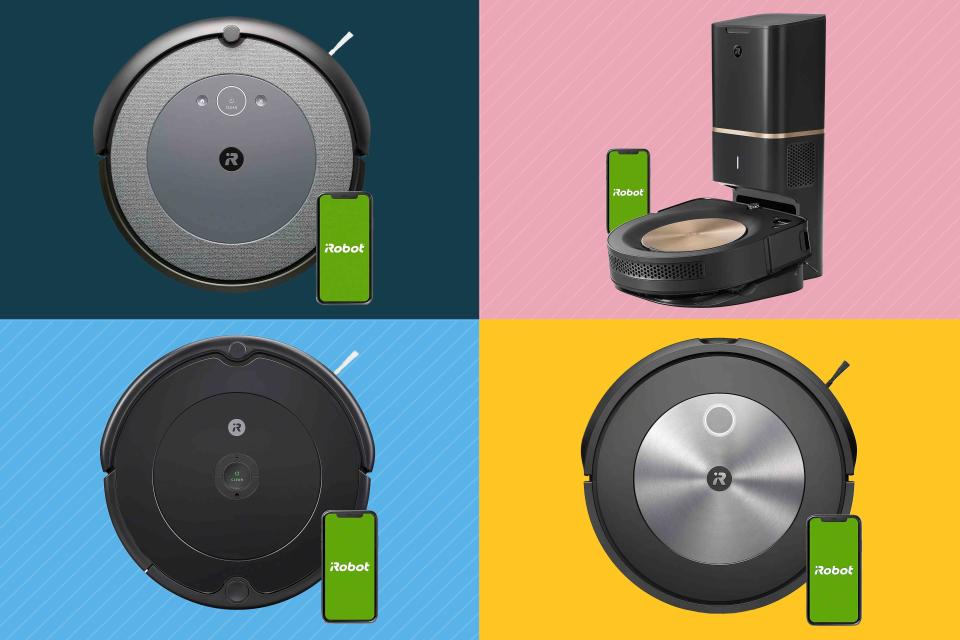
People / Brian Kopinski
When you think about the best robot vacuums, chances are the Roomba brand comes to mind. This well-known line of vacuums, created by iRobot, boasts powerful suction and impressive navigation abilities, and today, the brand offers a wide range of robot vacuum models, including several robot-mop combination units. Because there are so many options available, it can be tricky to figure out which one will work best in your home.
“iRobot offers several Roomba models designed to meet the needs of a range of customers, from entry-level Roomba models starting in the $200-$300 range to our flagship Roomba j9 Series that are iRobot’s smartest and most intelligent flooring cleaning robots to date,” explains Ryan Stocking, a product manager at iRobot. “When you’re shopping for a Roomba, there are several factors to keep in mind: budget, the size of your home, the level of clutter on the floors and whether or not you have pets.”
We wanted to see the difference between today’s most popular Roomba models, so we tested five of the brand’s top-rated products alongside dozens of other robot vacuums. We evaluated each model on things like ease of setup, effectiveness on different floor types, obstacle avoidance, and more, and we sorted them into their best use cases to help you find the right fit for your home.
Here are the best Roombas that PEOPLE Tested.
Best Overall: iRobot Roomba i3 EVO Robot Vacuum

Pros
Effectively picks up dirt and debris on carpeting and hard floors
The vacuum is quiet enough that it’s not disruptive while cleaning
This model is available with or without a self-emptying base
Cons
The vacuum does occasionally get stuck on obstacles
If you’re shopping for a robot vacuum, the Roomba i3 EVO will be a great addition to your home, helping to streamline your cleaning routine — without breaking the bank. This mid-tier model from iRobot offers good suction, smart mapping abilities, and a reasonable price point, and if you want a self-emptying model for less maintenance, you can upgrade to the Roomba i3+ EVO, which holds up to 60 days worth of debris in its base.
During testing, the i3 EVO proved to be effective on both hard floors and carpeting, picking up around 90 percent of dirt and debris. Its rubber brushrolls do a great job trapping dust and hair on all types of flooring, and the edge-sweeping brush helped it clean along baseboards — though, the vacuum wasn’t quite able to reach into corners. We also loved that this vacuum was quiet during operation, with a noise level of around 65 decibels.
Because it doesn’t offer obstacle avoidance abilities, the i3 EVO did occasionally get hung up on power cords and curtains, and it sucked up a sock on one cleaning run, as well. So, you will need to ensure your floors are free of obstacles before this robot starts cleaning — otherwise, you may have to give it a helping hand if it gets stuck somewhere.
It’s worth noting that iRobot recently updated its current lineup of robot vacuums and has stopped selling the i3 EVO on its website, replacing it with the new Roomba i4 EVO instead. (You can still get the i3 EVO from retailers like Amazon, though.) According to Stocking, the i4 EVO is the same robot, but it’s now equipped with a 20 percent larger battery, allowing it to clean for longer before recharging.
Price at time of publish: $299.99 (orig. $349.99)
Dimensions: 13.26 x 3.63 inches | Weight: 7.44 pounds | Dustbin Capacity: 0.5 liters | Runtime: 75 minutes | Smart Mapping: Yes | Self-Emptying: i3+ only
Best Value: iRobot Roomba 694 Robot Vacuum
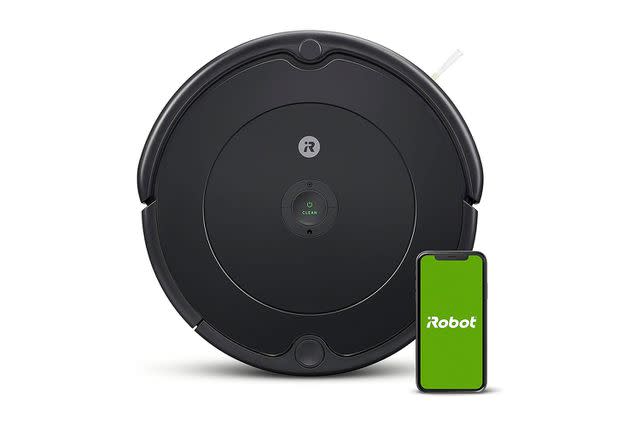
Pros
This model offers solid cleaning abilities and basic features for a low price
This Roomba does an effective job cleaning up debris of all sizes
While it doesn’t have smart mapping, the robot still navigates around obstacles easily and can find its way back to the dock
Cons
This model was one of the louder products during operation
Long hair gets tangled around the brushroll and needs to be cut off
Many of today’s best Roombas are equipped with high-end features like smart mapping and self-emptying dust bins, but if you want something simpler (and cheaper), the Roomba 694 is a great value. This basic robot vacuum punched above its weight class in our testing, effectively picking up all sorts of debris from both carpeting and hard floors. It had no problem tackling everything from Cheerios to pet hair, and even though it lacked smart mapping abilities, it was still able to navigate around obstacles like chairs and find its way back to the dock for charging.
The Roomba 694 connects to your smartphone, but you don't have to connect it to get a good clean. While its overall suction power is good, this model does have a few shortcomings to keep in mind: It isn’t able to avoid obstacles while cleaning — so you'll need to supervise it while it's running — and it’s also quite loud, with a noise level around 77 decibels while it works. Hair also gets wrapped around its brushrolls easily, so it may not be the best choice for anyone with long-haired pets.
Price at time of publish: $159.99 (org. $274.99)
Dimensions: 13.4 x 3.54 inches | Weight: 6.77 pounds | Dustbin Capacity: 0.35 liters | Runtime: 90 minutes | Smart Mapping: No | Self-Emptying: No
Best for Pet Owners: iRobot Roomba J7 Robot Vacuum

Pros
This model uses a methodical cleaning pattern and picks up the vast majority of debris
The dual rubber brushes are easy to clean and don’t get tangled with hair
Thanks to its obstacle recognition, it automatically avoids things like clothing and power cords
Cons
Despite the brand’s claims that it can avoid accidents, the j7 drove through a pile of fake pet waste during testing
Robot vacuums don’t always fare well in homes with pets — not only can they get clogged up with pet hair or stuck on rouge toys, but there are plenty of horror stories about robot vacuums driving through pet waste and spreading it all around the house. Thankfully, the Roomba j7 addresses these concerns with the brand’s best obstacle recognition and avoidance abilities. Plus, if you tend to have a lot of pet hair in your home, you can upgrade to the Roomba j7+, which has a self-emptying base that holds several weeks' worth of debris for reduced maintenance.
During testing, the Roomba j7 was able to pick up all the debris we threw at it, including dust, dirt, pet hair, and even pieces of kibble. Its dual rubber brushes did a great job capturing debris from hard floors, and they were very easy to remove and clean for periodic maintenance. We were also impressed with the robot’s obstacle avoidance — it managed to navigate around power cords and other items left on the floor.
The only area where it fell flat was our pet waste test: It drove straight through the fake poop we left on the floor. The good news, though, is that the brand backs this product with its Pet Owner Official Promise, which says they’ll replace the robot for free if it’s ever ruined by running over pet waste. (That doesn’t save you from having to clean up the mess smeared across your floor, but hey, it’s something.)
If you want the latest and greatest tech for your home, Stocking notes that the Roomba j7 was recently replaced with a new flagship model — the iRobot Roomba j9+. “The primary difference between the Roomba j9+ and Roomba j7+ is greater pick-up performance,” Stocking explains. “The Roomba j9+ has 100 percent more powerful suction than the Roomba i Series and comes with Carpet Boost, which enables the robot to automatically adjust its suction power on carpet or rugs.”
Price at time of publish: $379 (org. $599.99)
Dimensions: 13.3 x 3.4 inches | Weight: 7.49 pounds | Dustbin Capacity: 0.25 liters | Runtime: 75 minutes | Smart Mapping: Yes | Self-Emptying: j7+ only
Related: The 12 Best Pet Hair Vacuums for Sucking Up Fur, Dander, and Kibble
Best Design: iRobot Roomba s9+ 9550 Wi-Fi Connected Robot Vacuum
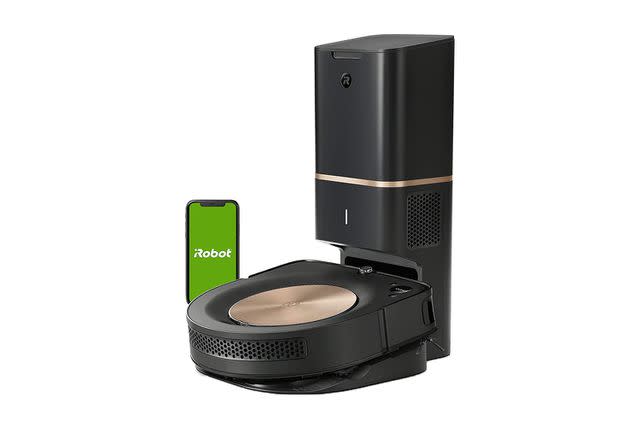
Pros
Thanks to its D-shaped design, this model is able to get into corners better
This model has powerful suction and is able to pick up debris of all sizes
Cons
This vacuum is quite loud and distracting during operation
Despite its price, this model lacks obstacle recognition and got stuck on power cords
The iRobot Roomba s9+ is the brand’s most high-end model, and it’s the only one with a D-shaped design. Thanks to its flat front end, the vacuum can get into corners and more closely along the edges of walls, and it also boasts the most powerful suction of all the Roombas available today. It was able to suck up debris of all sizes during our testing, and it often went over the same areas multiple times for a deeper overall clean.
The s9+ includes a self-emptying dustbin, and its large base can hold up to 60 days' worth of debris. It did a good job navigating around large obstacles like furniture, but we were a bit disappointed that it frequently ran over power cords and other small items left on the floor. It’s also quite loud while vacuuming, with an average noise level over 80 decibels.
If you’re trying to decide between the Roomba s9+ and j7+, there are a few key differences between these two models. The j7+ is much better at recognizing and avoiding obstacles like power cords, so it’s likely the better option for messier households. The s9+, on the other hand, can get into corners better thanks to its unique shape, and it also has more powerful suction. However, in our testing, both models did a great job picking up everyday dirt and pet hair.
Price at time of publish: $599.99 (org. $999.99)
Dimensions: 12.25 x 3.5 inches | Weight: 8.15 pounds | Dustbin Capacity: 1 liter | Runtime: 120 minutes | Smart Mapping: Yes | Self-Emptying: Yes
Best Self-Emptying: iRobot Roomba i7+ (7550) Robot Vacuum with Automatic Dirt Disposal

Pros
The self-emptying base can hold several weeks worth of debris
The vacuum is highly effective on small debris like dirt and cat litter
Does a good job updating its map if furniture is moved around
Cons
The vacuum frequently gets stuck on obstacles like power cords and area rugs
The Roomba i7+ is the brand’s original self-emptying model, and it can hold up to 60 days' worth of debris in its base, saving you from having to empty it after every cleaning session. During testing, we could often go several weeks before needing to change the collection bag, even when using the robot several times per week.
We found that the i7+ excels at picking up smaller debris like cat litter, dirt, and dust, but it’s not quite as effective on larger debris like cereal pieces, sometimes just pushing them across the floor. Its average noise level was around 78 decibels, and we noticed that this model did a good job updating its smart map if furniture was moved around between cleaning sessions. However, this robot vacuum frequently got hung up on obstacles, including power cords and even the edges of thick area rugs, and we often needed to intervene so it could continue cleaning.
There are a few key differences between the Roomba i7+ and j7+ to keep in mind as you decide which option is best for your home. They both can hold up to 60 days' worth of debris in their dust bins, but the j7+ has a more compact design. The j7+ also has obstacle avoidance and can recognize things like power cords, stray toys or clothing, and even pet waste, navigating around them as it cleans. The i7+ lacks this feature and would be better suited for people who keep their floors tidy.
Price at time of publish: $630.01
Dimensions: 13.34 x 3.63 inches | Weight: 7.44 pounds | Dustbin Capacity: 60 days | Runtime: 75 minutes | Smart Mapping: Yes | Self-Emptying: Yes
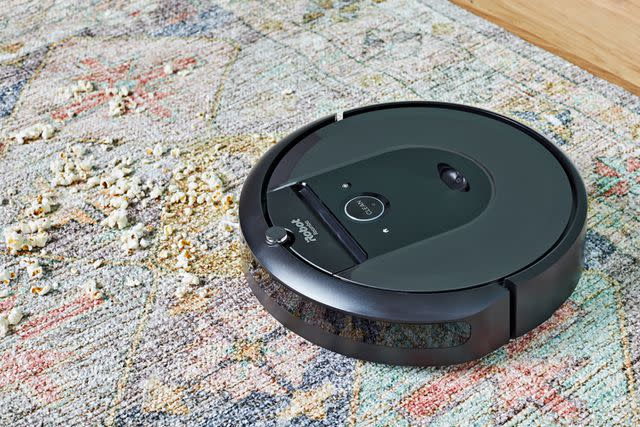
People / Henry Wortock
Other Roombas to Consider
iRobot Roomba i4 EVO ($295): The Roomba i4 EVO is the new, updated version of the i3 EVO. It has all the same features, including smart mapping and dual rubber brushes, but it’s equipped with a larger battery. This means it can clean for longer periods of time before needing to return to its base and recharge. It’s also available in a “Plus” model.
Roomba Combo i5 ($300): Roomba recently released several new robot vacuum and mop combo units, and the most affordable option is the i5. This model comes with a separate mopping module that you can attach in place of the traditional dust bin, allowing it to wash your hard floors with either plain water or a special cleaning solution.
Things to Consider Before Buying a Roomba
Self-Emptying
One of the biggest decisions you’ll have to make when selecting a Roomba is whether or not you want a self-emptying model. Products like the Roomba i3 EVO and Roomba 694 have a small on-board dustbin that generally needs to be emptied after every cleaning cycle, while any of the “Plus” models, such as the Roomba j7+, empty their dustbin into the base when it gets full.
“If you’re an allergy sufferer, pet owner, have children, or generally just want a hands-free cleaning experience, consider a Roomba with a self-emptying bin, which can empty up to 60 days' worth of dirt, debris, and pet fur in an enclosed bag,” recommends Stocking. “iRobot’s self-emptying Roomba robot vacuums expel their debris into a sealed bag, trapping and locking away the dirt and debris and preventing it from re-entering the home’s environment.”
Smart Mapping
Once upon a time, robot vacuums used to travel around the floor in a randomized pattern, bouncing off walls and other objects before heading in the opposite direction. Today’s Roombas work in a more methodical pattern, and some models also offer smart mapping abilities, which allow you to direct the vacuum to specific locations.
“Smart mapping robots can seamlessly and efficiently navigate an entire level of a home and keep track of its location,” explains Stocking. “Users can label rooms and clean them in any order they want and set up ‘Keep Out Zones’ for keeping the robot out of unwanted areas. Similarly, users can establish ‘Clean Zones’ so the robot will concentrate on more defined areas, such as in front of the living room couch, or under the dining room table.”
Obstacle Avoidance
Obstacle recognition and avoidance is another feature that you may want to look for in a Roomba. One common complaint about robot vacuums is that they can get stuck on things like power cords or even small area rugs, but certain Roombas — namely the Roomba j7 — have sensors that allow them to avoid these obstacles.
“If you have a mix of floor types or your floors are often cluttered — perhaps you have children or pets — you should consider a Roomba with object detection and avoidance, such as the Roomba j Series,” says Stocking. “These robots are trained to identify common hazards on the floor, such as shoes, socks, clothes, cords, backpacks, and even pet waste.”
Budget
Roombas can vary significantly in price — you can pay as little as $150 or upward of $1,000, depending on the model you select. You’ll want to take your budget into account as you shop, and rest assured that even the cheaper models will do a good job picking up dirt off your floor. However, more expensive models are generally equipped with advanced features like smart mapping and obstacle avoidance.
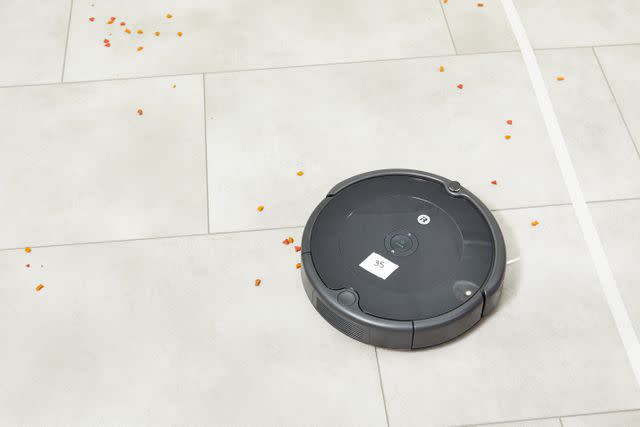
People / Rachel Marek
How We Tested
We tested all of the current iRobot Roomba vacuums alongside dozens of other robot vacuum cleaners. For each model, we evaluated them in the following areas:
Setup: While setting up each robot vacuum, we timed how long it took to unbox the product and get it ready for testing. We noted whether the process was intuitive and if we had any issues connecting smart models to the Wi-Fi network.
Effectiveness: To assess each vacuum’s suction power and debris pickup, we created a test area with both hard floors and carpeting. We spread several types of debris on the floor, including hair, Cheerios, and sand, and we noted how much of each material the vacuum was able to pick up.
Noise Level: To measure how loud each vacuum is while cleaning, we used a decibel meter to test the noise level in a small room with a closed door.
Maneuverability: During testing, each vacuum had to navigate around large obstacles, including a medium-pile area rug, couch, and coffee table. We also tested their ability to avoid small items that may be left on the floor, including a USB cable, a baby sock, and a glob of chocolate pudding, which we used to imitate pet waste.
Emptying: We assessed each vacuum on how much debris it could hold and how often it needed to be emptied, noting whether the process was straightforward, easy to accomplish, and/or messy.
Long-Term Testing: In addition to lab testing, we also sent each Roomba model home with one of our testers for long-term evaluation. Testers used each vacuum in their homes over the course of three or more months, and they answered questions about how the vacuum fit into their cleaning routine and whether there were any performance changes after several weeks of use.
Frequently Asked Questions
What model of Roomba is the best?
The best Roomba model for your home will depend on how you plan to use it, how neat your home is, and whether you want any special features. For most people, we think the iRobot Roomba i3 EVO is a solid pick for supplementary cleaning — it’s not too expensive, does a good job picking up debris, and can navigate around most large obstacles.
However, pet owners or those with messy households may want to upgrade to a model like the iRobot Roomba j7, which has better obstacle avoidance abilities and won’t get hung up on power cords, toys, or stray articles of clothing.
What is the downside to Roombas?
Even though some Roomba models cost more than full-size vacuums, they’re still only meant to be supplementary cleaning tools. You’ll still need to regularly vacuum your home with a full-size vacuum, which will give you a much deeper clean, especially on carpeting or along the edges of walls.
Another common complaint about Roombas — and robot vacuums in general — is that they can easily get stuck on obstacles like power cords, so you may find that you have to clean up the floor before your vacuum runs.
Should I run my Roomba every day?
The beauty of Roombas is that you can schedule them to run as frequently as needed for your home. Some people choose to run their robot vacuum once a week, while others have their vacuums clean every day. If you have pets or a high-traffic area that gets dirty quickly, having your Roomba vacuum daily can help keep your home cleaner. Just keep in mind that the more often you run your vacuum, the more frequently it will need maintenance, such as emptying the dustbin and cleaning off the brushrolls.
Why Trust PEOPLE?
Camryn Rabideau is a freelance writer and product reviewer who specializes in home, kitchen, and pet products, and she’s personally tested dozens of different robot vacuums, including Roombas, in her career. To compile this roundup, she consulted our testing insights for information on all the different Roomba models we tested, taking into account each product’s overall scores and their best use cases.
Our Experts
Ryan Stocking is a product manager at iRobot, and he offered insights on the differences between popular Roomba models as well as newly launched robot vacuums we haven't yet tested.
What Is People Tested?
We created the PEOPLE Tested seal of approval to help you find the very best products for your life. We use our unique methodology to test products in three labs across the country and with our network of home testers to determine their effectiveness, durability, ease of use, and so much more. Based on the results, we rate and recommend products so you can find the right one for your needs.
But we don’t stop there: We also regularly re-review the categories in which we’ve awarded the PEOPLE Tested seal of approval — because the best product of today might not be the best of tomorrow. And by the way, companies can never buy our recommendation: Their products must earn it, fair and square.
In short, PEOPLE Tested provides recommendations you can trust — every day, every purchase.
For more People news, make sure to sign up for our newsletter!
Read the original article on People.

